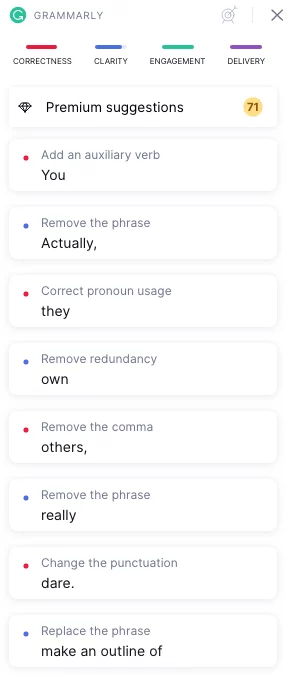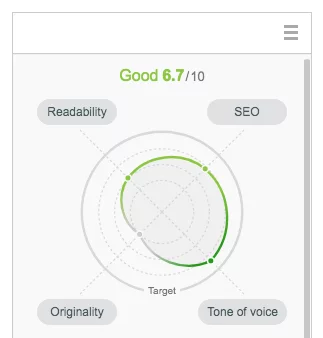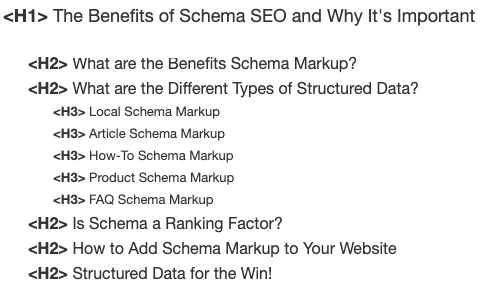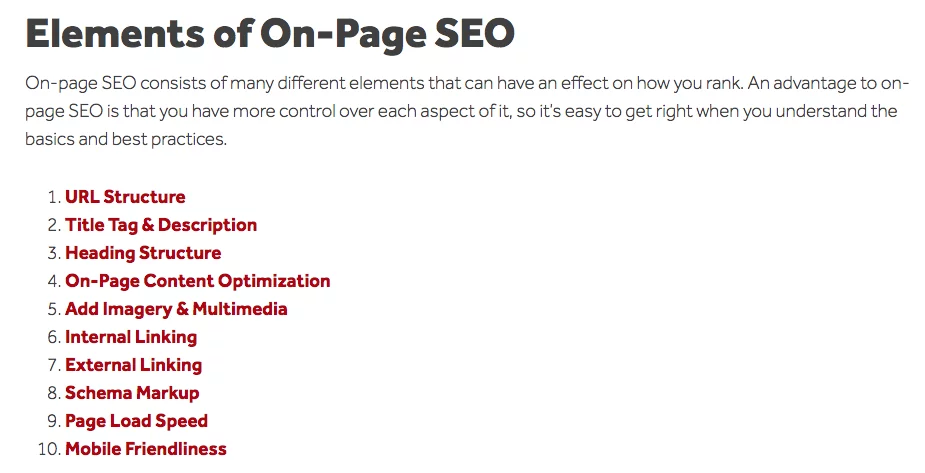The 18 Ingredients That Make Great SEO Content
You know how there are websites?
Well, without content, all those billions of sites would be worth no more than crinkled-up cellophane candy wrappers.
When I talk about SEO content in general, I don’t just mean the written word that you see in blog posts, service pages, and long-form resource pages.
I could also refer to videos, podcasts, and infographics.
Except here, I’m not.
I’m referring to written website content, specifically, how you should go about writing it for your site.
There are probably SEO beginners out there who think they would make good SEO content writers just because they can write well enough and always did well on school papers.
I used to think that way, too (oh, and we’ll come back to the issue of school papers later). The thing about it is, writing skills are necessary but not sufficient for generating quality SEO content.
There is a way to go about your content marketing that will actually appeal to online users and rank well on Google. Actually, there are 18 tactics you should keep in mind as you craft content for your website.
Some of these things I derived from common sense, and they won’t surprise you.
Others come from a deep wellspring of arcane knowledge that I keep for myself and share only once in a while.
So pay attention.
Here are 18 ingredients that will make great SEO content for your website.
1. Perform Keyword Research
For the most part, I did not want to structure this item list in order of importance, but it just makes sense to start with this one: keyword research!
Experienced SEOs know the whole story: keywords used to be crazy important to include in website content because Google saw them in content and then ranked that content on that basis.
And while things certainly aren’t that simple anymore, Google still needs to see those signals that tell it what your content is about.
You should use tools such as Semrush or Google Keyword Planner to discover the search volumes of keywords you want to target in your content.

For instance, I did keyword and topic research (more on topic research soon) to determine what the title of this blog post should be. Ultimately, it wouldn’t be a tragedy if I titled it something different, but this one has the most existing traction and gives my content the best chance of getting found organically.
The other thing that matters here is that the title should be attention-grabbing. It should be clear about what it is presenting but also provocative enough to convince those on the fence to click on it and read it.
The next point is related to this subject, too, so let’s move on.
2. Analyze the Competition
Doing your own keyword research is important, but so is seeing what other people have done in the subject area you’re covering.
Think about it like this: everyone out there who is already ranking on page 1 for the subject you’re writing about (and there will almost always be others, since there’s really nothing new anymore) is your competitor.

They want to be number 1 for your subject.
Are you just going to take that?
If you want to unseat these people from their lofty thrones, you have to be better than they are.
That means doing better research, including better images of infographics in your content, and generally being more comprehensive than all the others.
Creating SEO content is a fight to be the most useful to readers. Whoever does it best will win the SERPs.
So it makes sense that you should analyze the competition to see what they’ve done and how you can do it better.
Don’t copy the work. Don’t you dare.
But just strive to make your piece the best resource on the internet on this particular subject.
3. Answer Questions
If we’re talking about being useful to people, then your content should address actual questions that users have.
This is the sole point of SEO content, and it should be foremost in your content strategy: to answer people’s real questions. When you provide those answers, people will want to access your content to see what you have to say and what kind of services you can offer them.
But how do you find out what people are asking online?
One way is to reread item #2 here.
Another is to go almost directly to the source: check out Semrush’s topic research tool, BuzzSumo, Answer the Public, or the fairly new Google Question Hub to get aggregated lists of trending headlines and questions that human users have been searching.

Once you have the questions, you can go and research the answers and write your content.
Make sure each page you write has a goal, a purpose that will drive your writing. Stay focused on what questions you want to answer.
It may help if you make an outline of your content piece before you start writing so you can keep the writing within your scope and not try to rank for too much at once, which can actually be harmful to your rankings.
4. Keep Target Audiences in Mind
Related to item #3 is keeping your target audiences in mind as you write.
You should be able to determine basically who your audience is from the question being asked.
If you’re addressing the question, “How do lawyers get paid?” you can assume the asker is a layperson, someone who isn’t a lawyer but is possibly considering hiring one. Therefore, you should keep your language easy and free of legal jargon. You’ll appeal to the common person that way.
It doesn’t mean talking down to anyone. Instead, keeping your audience in mind simply means being consistent in your tone and purpose throughout your writing. Don’t lose sight of your objective halfway through, or start changing your writerly voice toward the end.
Staying consistent, being comprehensive, and knowing who’s reading your work are the only ways your SEO content is going to be effective. If audiences read your content and feel that you understand their concerns, you’ll have done what you set out to do.
5. Don’t Oversell
Here’s another quick point.
When you’re writing SEO content, despite the fact that you are trying to sell something, don’t come off like you’re trying to sell something.
At the same time, don’t be dishonest about anything, either.
You want to address the question to the best of your abilities for the audience who has asked it, but don’t be a pushy salesperson while you’re doing it. That turns people right off.
Imagine if I opened this blog post with something like: “So, you want to know how to write effective website content? I’ll help you out, but to be sure you’re getting the best work for your site, you need to hire the content experts at LSEO.”
Ehhh, that’s kind of vulgar. Who’s going to keep reading? It isn’t even phrased elegantly.
Instead, to increase user engagement on this post, I knew I’d have to provide real, valuable information, stuff people can use.
Yes, you want your SEO content to drive online conversions for you, but if your information answers the question well enough, the selling should take care of itself.
Authoritative content establishes trust, and when people trust you, they are more likely to buy from you.
6. Don’t Write a School Paper
Okay, we’re back with the school papers.
Don’t write them.
They tend not to work in today’s SEO.
What do I mean?
When you’re writing, you should not attempt to sound like you’re back in school trying to impress the professor. You should not write something that reads like a doctoral dissertation, with stiff, formal language punctuating every last sentence.
That’s because that isn’t exactly user friendly, and if it isn’t friendly to users, why are you writing it? You should write as you would speak this information to someone.
I learned that the hard way with my old music blog. I started off writing thesis-level stuff about the brain and music. It was hard to advertise it to people. I then moved into more popular topics while making my writing more conversational.
And I later got better responses.
See, the thing is, people don’t talk in formal academic language.
You know how, if you go to read Charles Dickens or the U.S. Constitution, the wording is obviously in English but sounds kind of off-beat?
Yeah, that’s what I mean. It’s dry, it’s outdated, and it’s a little boring.
So, don’t make your content that way. Look up there. I said “yeah.” Don’t write that in a school paper, but if you think it fits the conversational tone of your SEO content, go for it, with enthusiasm.
However you want to do it, just make sure you present your information in ways that won’t make your readers’ eyes glaze over, and your content will do a much better job of serving users.
Remember: Google knows how to process natural language, particularly after 2019’s BERT update.
7. Don’t Duplicate Content
Let’s talk about school one more time.
Remember when you were in school, and the teacher said, “Don’t plagiarize, or I’ll fail you”?
The same idea applies here. You can’t plagiarize other people’s SEO content, and you certainly can’t duplicate your own content on your site.
Google prioritizes content that is original and useful, and you can’t be original if you’re using substantial amounts of content in more than one place on your website.
To Google, duplicated content will result in bad user experiences, since people who read content that they’ve seen elsewhere will probably start to doubt the integrity of your site.
It’s simple: don’t copy content from anywhere, including your own site. Write everything fresh, and Google will take notice.
8. Break Up Paragraphs
The next few items are some little mechanical things to keep in mind as you write.
If you look around this post, do you notice how few to no paragraphs are longer than three lines?
Well, that isn’t some accident.
It’s because I know how fleeting the average modern human’s attention span is (the answer is 8 to 12 seconds).
I also know that your average person doesn’t like to do too much work or engage in activities that are too mentally taxing.
And reading kind of fits the bill for those things.
So, the problem for me becomes, “How do I encourage the everyday human to get through a blog post that’s shaping up to be more than 3,000 words?”
The answer is, “Break up the post’s paragraphs into digestible chunks.”
That line above is pretty easy to read. But what if I combined the previous few lines into one paragraph that was five or ten lines long?
Well, suddenly, those digestible chunks seem less like fun little cookies and more like a huge, steaming crown of broccoli.
I’d probably lose readers with every crown.
So, to give the impression that I’m writing less than I am, purely from a visual perspective, I write paragraphs of one or two lines.
And you should, too.
More people will stay on the page, which will keep your bounce rate down, and that will tell Google you’re doing something right.
Finally, that will get you ranked higher, where people can see you.
9. Use Proper Grammar
Wow, here’s number 9, and it’s called “use proper grammar.”
No, don’t laugh. You’d be surprised at how necessary it actually is to say this.
When you write, you should always be sure that you’re using the right grammar, syntax, spelling, and all the other elements of the language in which you’re writing.
Do these things affect SEO?
The short answer is “yes,” and here’s why.
If you don’t use the proper grammar, and if you spell things incorrectly and don’t care enough to correct them, then you are most likely going to lose users who no longer trust you.
Think about it: if you’re reading web content written by someone who doesn’t care enough to fix typos, then why would you trust that business with your money?
Your website is often the first impression the public gets of your company. Make it a good one, or you may not get a second chance.
By the way, people leaving after seeing a few typos will shoot up your bounce rate and signal to Google that you aren’t worth ranking.
A tool like Grammarly is great for checking your grammar.

10. Use a Content Checker
If you struggle with grammar and sentence structure, use a tool such as Grammarly to identify where you can improve your content.
You might think you’re a great writer who really doesn’t make mistakes, and maybe you are for the most part.
But there are always cases when even the best among us slip up and don’t even notice it.
That’s okay. Grammarly will catch whatever it is and suggest a correction.
When it comes to the SEO quality of your content, you can use Semrush’s writing assistant for some pointers.

The tool will score your writing based on originality, readability, SEO, and tone of voice and make suggestions for these areas.
The higher your score on the scale from 1 to 10, the more SEO friendly your content is.
11. Use Calls to Action (CTAs)
Even though we don’t want to use SEO content to hard-sell things to people, we are still out to make money here.
Let’s be real.
What should you do to guide that process along?
They’re called calls to action, or CTAs, and all of your SEO content should include them.
Your content should invite readers to take action, whatever that means for your business. After presenting all your information, say something like, “Book an appointment now,” “Set up your free consultation,” or “Request your free demo.”

People can get lost in your content otherwise. The information might be great and exactly what they were looking for, but if people don’t know what to do next, they probably won’t convert.
Don’t leave users hanging. Use strong CTAs in your content to get them to take the next step.
12. Properly Name Images and Alt Text
Here’s a quick one. If you’re adding images to your content, be sure to include alt text in the back end of your site.
Alt text helps people to know what an image shows if they can’t see it, for instance, if it can’t load. Alt text also helps Google to understand what an image contains and therefore index it properly.
Basically, adding alt text to describe an image’s contents will only help with your SEO, so be sure to do it.
13. Use Internal Linking
When writing your content, be sure to link internally to other pages on your site. Doing this shares ranking authority among pages and is actually the best way to send traffic around your site and increase your overall click-through rate.
If you’re writing a blog post about hiring a personal injury lawyer, at some point in that post, you should link to your main personal injury page.
The blog post acts as supporting content for that main content. It holds up the main content by existing on your site as useful information that also links back to a service page.
If you have blog content on your site that isn’t linking to a main page, you’re missing a ton of opportunity. That’s one major reason why the blog post should be there!
14. Use Proper Meta Tags
Every piece of content you write should include a set of properly written meta tags, meaning titles and descriptions.
The meta title should include a keyword you’re trying to rank for and describe what the content is about. In most cases, a meta title is the title of the content. Don’t forget to include your company name after the pipe.
Then, the meta descriptions should also include a keyword, either the primary keyword or another, semantically related secondary one. It should further describe the content and always use a CTA at the end to encourage users to take this or that action.
15. Use a Proper Heading Structure
In the area of user friendliness, there’s yet another vital point to mention: using the proper heading structure throughout your content.
Have you noticed that I’ve been using the listicle format here in this blog post? The numbered items help to break things up, and that’s for a few reasons.
For one thing, you aren’t intimidated by a gigantic wall of text that’s just too dense to break through. And for another thing, my headings give readers the opportunity to skim the content to see what lies ahead and what they might be interested in reading first.
Headings are good for Google, too, since they label content sections by topic and can contain keywords for which the content can rank. Google assigns more importance to whatever is contained in H1s and H2s, the main headings and subheadings of a piece.

If you are able to use keywords in those headings, go for it. That will help Google to know what your content is and how and where to rank it on the SERPs.
16. Use Jump Links for Long Articles
Whenever you have an especially long piece of content that isn’t already divided into easily digestible portions, you will want to include jump links near the top of the content.
Jump links are there to enhance the user experience. They help readers to get around the content instantly, skimming the jump links first to see what they’d like to go to first. Returning readers can also quickly navigate to where they left off with the help of jump links.

17. Set Deadlines
Look, I get it. Writing is not for everyone. Some people dread it. Some people can’t stop writing. Some people write a 3,000-word blog post.
No matter what your attitude is toward writing, it’s important to set deadlines for getting it done. If you’re writing content that’s too long to complete in one go, then break your deadlines down into miniature deadlines.
Tell yourself you’re going to write a third of the content in three days’ time, the second third in the next three days, and then finish it all in three more days.
Keeping to a schedule like this will benefit your website because Google rewards those sites that consistently update themselves with new content.
If your company has a blog as part of its site, don’t let it go! Consider that blog to be one of your greatest SEO resources, because it is!
18. Review Before Publishing
Okay, last point: for the love of all that is good in SEO, please review your content before publishing it.
We have all made content errors before, and published them, too. But if you want to be engaging for users, if you want Google to see you as authoritative and worthy of some good rankings, publish accurate and error-free content.
Even if you think you’re a phenomenal writer, review before you publish. We’re all capable of oversights.
Your audience deserves the quality content that you can produce by devoting some extra love and attention to your writing. So, be sure to give your content those things before sending it off on its own on the great, big internet.
Master Your Website’s SEO Content with LSEO
Generating useful SEO content for your website isn’t difficult if you know what you’re doing. SEOs long ago figured out how to get new content ranked on Google, but it’s all a matter of executing it.
This guide will help you do that if you’re struggling.
And don’t forget, you can learn more about expert SEO content marketing by contacting us here at LSEO. We can guide you in crafting your own content, or we can research and write content for you.
In any event, take these 18 ingredients that I’ve discussed here and mash them all together in a pot, and then you can come out with some great SEO content, too!



